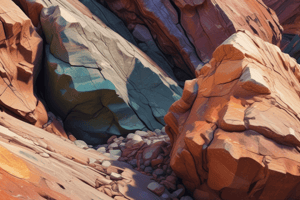Podcast
Questions and Answers
What is the primary component that makes up limestone?
What is the primary component that makes up limestone?
- Iron oxide
- Clay
- Sand
- Calcium carbonate (correct)
Which rock is formed from the compression of dead sea creature remains?
Which rock is formed from the compression of dead sea creature remains?
- Marble
- Limestone (correct)
- Sandstone
- Quartzite
Which type of rock is specifically described as a metamorphic rock?
Which type of rock is specifically described as a metamorphic rock?
- Limestone
- Marble (correct)
- Sandstone
- Quartzite
What characteristic distinguishes quartzite from sandstone?
What characteristic distinguishes quartzite from sandstone?
Which of these uses is associated with marble?
Which of these uses is associated with marble?
Where can you find white marble in Ireland?
Where can you find white marble in Ireland?
Which rock is known for being smooth and extremely hard?
Which rock is known for being smooth and extremely hard?
What process contributes to the formation of sandstone?
What process contributes to the formation of sandstone?
Flashcards
Energy resources
Energy resources
Materials that create electricity or move objects.
Natural energy resources
Natural energy resources
Resources created naturally by the Earth.
Renewable resources
Renewable resources
Energy sources that can be used again and again.
Non-renewable resources
Non-renewable resources
Signup and view all the flashcards
Solar power
Solar power
Signup and view all the flashcards
Wind energy
Wind energy
Signup and view all the flashcards
Tidal energy
Tidal energy
Signup and view all the flashcards
Hydroelectric power
Hydroelectric power
Signup and view all the flashcards
Biomass energy
Biomass energy
Signup and view all the flashcards
Geothermal energy
Geothermal energy
Signup and view all the flashcards
Fossil fuels
Fossil fuels
Signup and view all the flashcards
Oil
Oil
Signup and view all the flashcards
Gas
Gas
Signup and view all the flashcards
Coal
Coal
Signup and view all the flashcards
Peat
Peat
Signup and view all the flashcards
Domestic purposes
Domestic purposes
Signup and view all the flashcards
Transport
Transport
Signup and view all the flashcards
Industry & business
Industry & business
Signup and view all the flashcards
What is a natural energy resource?
What is a natural energy resource?
Signup and view all the flashcards
What are the main uses of energy resources?
What are the main uses of energy resources?
Signup and view all the flashcards
What is sandstone made of?
What is sandstone made of?
Signup and view all the flashcards
How is limestone formed?
How is limestone formed?
Signup and view all the flashcards
What is the difference between limestone and marble?
What is the difference between limestone and marble?
Signup and view all the flashcards
What is quartzite?
What is quartzite?
Signup and view all the flashcards
How is sandstone used?
How is sandstone used?
Signup and view all the flashcards
How is limestone used?
How is limestone used?
Signup and view all the flashcards
How is marble used?
How is marble used?
Signup and view all the flashcards
How is quartzite used?
How is quartzite used?
Signup and view all the flashcards
Microscope Light Source
Microscope Light Source
Signup and view all the flashcards
Eyepiece Cover
Eyepiece Cover
Signup and view all the flashcards
Lowest Power Lens
Lowest Power Lens
Signup and view all the flashcards
Prepared Slide
Prepared Slide
Signup and view all the flashcards
Stage Hole
Stage Hole
Signup and view all the flashcards
Slide Clip
Slide Clip
Signup and view all the flashcards
Field of Vision
Field of Vision
Signup and view all the flashcards
Coarse Focus Wheel
Coarse Focus Wheel
Signup and view all the flashcards
Fine Focus Wheel
Fine Focus Wheel
Signup and view all the flashcards
Nosepiece
Nosepiece
Signup and view all the flashcards
Objective Lens
Objective Lens
Signup and view all the flashcards
Magnification Increase
Magnification Increase
Signup and view all the flashcards
Refocus
Refocus
Signup and view all the flashcards
Highest Power Objective Lens
Highest Power Objective Lens
Signup and view all the flashcards
Diagram
Diagram
Signup and view all the flashcards
H.P.
H.P.
Signup and view all the flashcards
Labelled Diagram
Labelled Diagram
Signup and view all the flashcards
Observations
Observations
Signup and view all the flashcards
High Power
High Power
Signup and view all the flashcards
Study Notes
Limestone
- Limestone is primarily composed of calcium carbonate.
Fossiliferous Rock
- Limestone is formed from the compression of dead sea creature remains.
Metamorphic Rock
- Marble is a metamorphic rock.
Quartzite vs. Sandstone
- Quartzite is a metamorphic rock that is formed from the transformation of sandstone under heat and pressure.
Uses of Marble
- Marble is frequently used in sculptures and buildings.
White Marble in Ireland
- White marble can be found in County Galway, Ireland.
Smooth and Hard Rock
- Marble is known for its smooth, polished surface and extreme hardness.
Sandstone Formation
- Sandstone is formed through the accumulation and cementation of sand grains.
Studying That Suits You
Use AI to generate personalized quizzes and flashcards to suit your learning preferences.
Related Documents
Description
Test your knowledge on various types of rocks and their properties with this engaging quiz. You'll explore limestone, marble, quartzite, and sandstone, and learn about their formation processes and uses. Perfect for geology enthusiasts or students!




